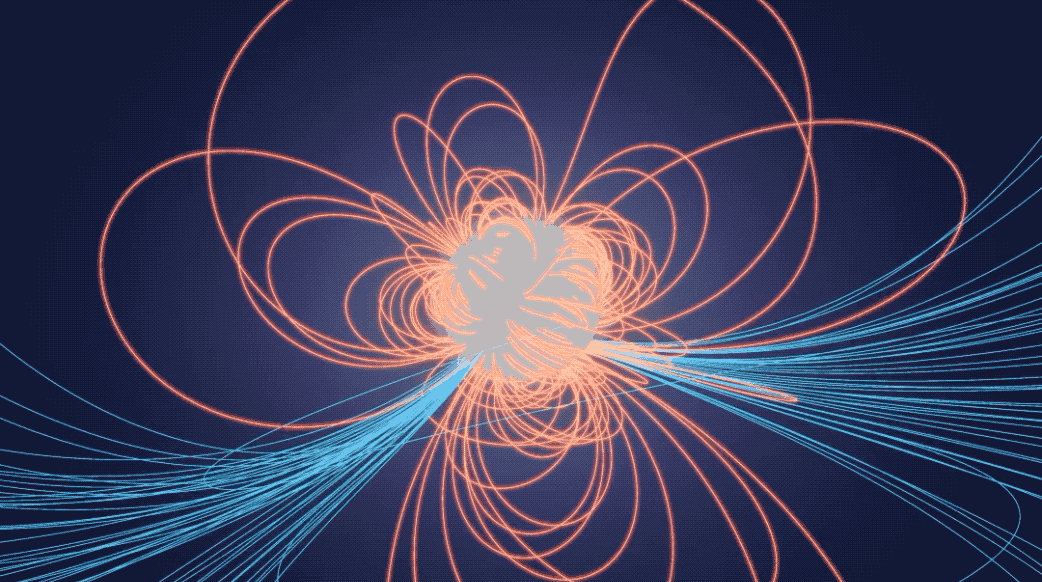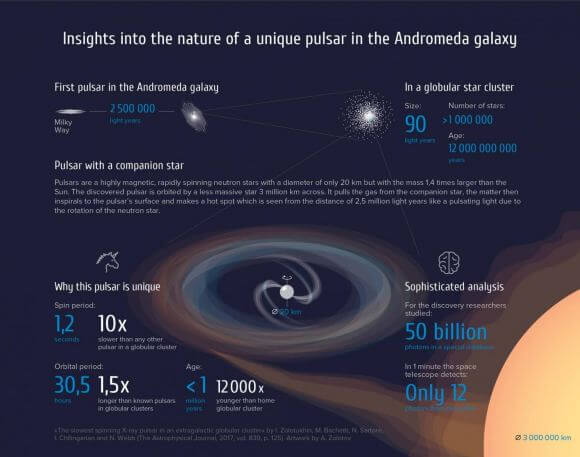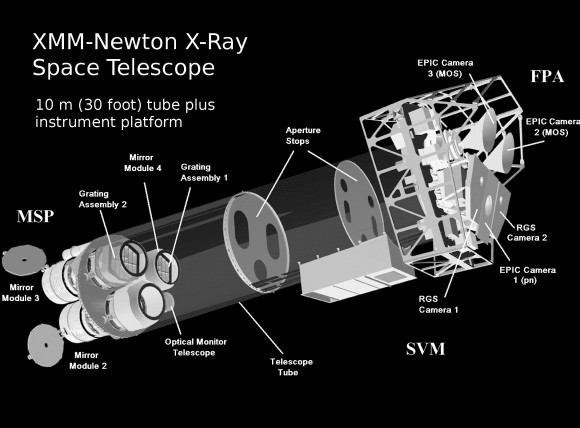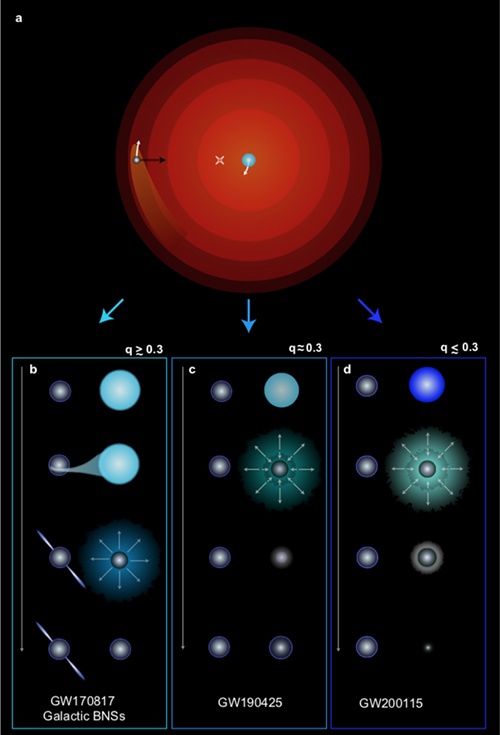We have been treated to some amazing aurora displays over recent months. The enigmatic lights are caused by charged particles from the Sun rushing across space and on arrival, causing the gas in the atmosphere to glow. Now researchers believe that even on exoplanets around pulsars we may just find aurora, and they may even be detectable.
Continue reading “Planets Orbiting Pulsars Should Have Strange and Beautiful Auroras. And We Could Detect Them”Fermi has Found More than 300 Gamma-Ray Pulsars

In June 2008, the Gamma-ray Large Area Space Telescope began surveying the cosmos to study some of the most energetic phenomena in the Universe. Shortly after that, NASA renamed the observatory in the Fermi Gamma-ray Space Telescope in honor of Professor Enrico Fermi (1901-1954), a pioneer in high-energy physics. During its mission, Fermi has addressed questions regarding some of the most mysterious and energetic phenomena in the Universe – like gamma-ray bursts (GRBs), cosmic rays, and extremely dense stellar remnants like pulsars.
Since it began operations, Fermi has discovered more than 300 gamma-ray pulsars, which have provided new insights into the life cycle of stars, our galaxy, and the nature of the Universe. This week, a new catalog compiled by an international team contains the more than 300 pulsars discovered by the Fermi mission – which includes 294 confirmed gamma-ray-emitting pulsars and another 34 candidates awaiting confirmation. This is 27 times the number of pulsars known to astronomers before the Fermi mission launched in 2008.
Continue reading “Fermi has Found More than 300 Gamma-Ray Pulsars”For its Next Trick, Gaia Could Help Detect Background Gravitational Waves in the Universe

Ripples in a pond can be captivating on a nice sunny day as can ripples in the very fabric of space, although the latter are a little harder to observe. Using the highly tuned Gaia probe, a team of astronomers propose that it might just be possible to detect gravitational waves through the disturbance they impart on the movement of asteroids in our Solar System!
Continue reading “For its Next Trick, Gaia Could Help Detect Background Gravitational Waves in the Universe”Gravitational Waves Reveal Surprising Secrets About Neutron Stars
The confirmation of gravitational waves back in 2017 continues to unlock whole new worlds of physics but also continues to elicit further questions. The detection of each gravitational wave brings a new challenge – how to find out what caused the event. Sometimes that is harder than it sounds. Now a team led by Alejandro Vigna-Gomez of the University of Copenhagen thinks they found a model of star death that helps to explain some previously inexplicable findings – and points to a galaxy with many more massive neutron stars than previously thought.
Continue reading “Gravitational Waves Reveal Surprising Secrets About Neutron Stars”Only 31 Magnetars Have Ever Been Discovered. This one is Extra Strange. It’s Also a Pulsar
Some of the most stunningly powerful objects in the sky aren’t necessarily the prettiest to look at. But their secrets can allow humanity to glimpse some of the more intricate details of the universe that are exposed in their extreme environs. Any time we find one of these unique objects it’s a cause for celebration, and recently astronomers have found an extremely unique object that is both a magnetar and a pulsar, making it one of only 5 ever found.
Continue reading “Only 31 Magnetars Have Ever Been Discovered. This one is Extra Strange. It’s Also a Pulsar”Pulsars Confirm One of Einstein’s Best Ideas, That Freefall Really Feels Like You’re Experiencing a Lack of Gravity

Six and a half decades after he passed away, famed theoretical physicist Albert Einstein is still being proven right! In addition to General Relativity (GR) being tested under the most extreme conditions, lesser-known aspects of his theories are still being validated as well. For example, GR predicts that gravity and inertia are often indistinguishable, in what is known as the gravitational Strong Equivalence Principle (SEP).
Thanks to an international team of researchers, it has been proven under the strongest conditions to date. By precisely tracking the motion of a pulsar, the team demonstrated that gravity causes neutron stars and white dwarf stars to fall with equal accelerations. This confirms Einstein’s prediction that freefall accurately simulates zero-gravity conditions in all inertial reference frames.
Continue reading “Pulsars Confirm One of Einstein’s Best Ideas, That Freefall Really Feels Like You’re Experiencing a Lack of Gravity”Astronomers Map the Surface of a Pulsar

When stars exhaust their supply of fuel, they collapse under their own weight and explode, blowing off their outer layers in an event known as a “supernova”. In some cases, these events leave behind neutron stars, the smallest and densest of stellar objects (with the exception of certain theoretical stars) that sometimes spin rapidly. Pulsars, a class of neutron star, can spin up to several hundred times per second.
One such object, designated J0030+0451 (J0030), is located about 1,100 light-years from Earth in the Pisces constellation. Recently, scientists using NASA’s Neutron star Interior Composition Explorer (NICER) were able to measure the pulsar’s size and mass. In the process, they also managed to locate the various “hot spots” on its surface, effectively creating the first map of a neutron star.
Continue reading “Astronomers Map the Surface of a Pulsar”Pulsar Seen Speeding Away From the Supernova That Created it

When a star exhausts its nuclear fuel towards the end of its lifespan, it undergoes gravitational collapse and sheds its outer layers. This results in a magnificent explosion known as a supernova, which can lead to the creation of a black hole, a pulsar or a white dwarf. And despite decades of observation and research, there is still much scientists don’t know about this phenomena.
Luckily, ongoing observations and improved instruments are leading to all kinds of discoveries that offer chances for new insights. For instance, a team of astronomers with the National Radio Astronomy Observatory (NRAO) and NASA recently observed a “cannonball” pulsar speeding away from the supernova that is believed to have created it. This find is already providing insights into how pulsars can pick up speed from a supernova.
Continue reading “Pulsar Seen Speeding Away From the Supernova That Created it”Carnival of Space #583
Welcome to the 583rd Carnival of Space! The Carnival is a community of space science and astronomy writers and bloggers, who submit their best work each week for your benefit. We have a fantastic roundup today so now, on to this week’s worth of stories!
Continue reading “Carnival of Space #583”
An Aging Pulsar has Captured a new Companion, and it’s Spinning back up Again
When massive stars reach the end of their life cycle, they explode in a massive supernova and cast off most of their material. What’s left is a “milliscond pulsar”, a super dense, highly-magnetized neutron star that spins rapidly and emit beams of electromagnetic radiation. Eventually, these stars lose their rotational energy and begin to slow down, but they can speed up again with the help of a companion.
According to a recent study, an international team of scientists witnessed this rare event when observing an ultra-slow pulsar located in the neighboring Andromeda Galaxy (XB091D). The results of their study indicated that this pulsar has been speeding up for the past one million years, which is likely the result of a captured a companion that has since been restoring its rapid rotational velocity.
Typically, when a pulsars pairs with an ordinary star, the result is a binary system consisting of a pulsar and a white dwarf. This occurs after the pulsar pulls off the outer layers of a star, turning it into a white dwarf. The material from these outer layer then forms an accretion disk around the pulsar, which creates a “hot spot” that radiates brightly in the X-ray specturum and where temperatures can reach into the millions of degrees.
The team was led by Ivan Zolotukhin of the Sternberg Astronomical Institute at Lomonosov Moscow State University (MSU), and included astronomers from the University of Toulouse, the National Institute for Astrophysics (INAF), and the Smithsonian Astrophysical Observatory. The study results were published in The Astrophysical Journal under the title “The Slowest Spinning X-Ray Pulsar in an Extragalactic Globular Cluster“.
As they state in their paper, the detection of this pulsar was made possible thanks to data collected by the XMM-Newton space observatory from 2000-2013. In this time, XMM-Newton has gathered information on approximately 50 billion X-ray photons, which has been combined by astronomers at Lomosov MSU into an open online database.
This database has allowed astronomers to take a closer look at many previously-discovered objects. This includes XB091D, a pulsar with a period of seconds (aka. a “second pulsar”) located in one of the oldest globular star clusters in the Andromeda galaxy. However, finding the X-ray photos that would allow them to characterize XB091D was no easy task. As Ivan Zolotukhin explained in a MSU press release:
“The detectors on XMM-Newton detect only one photon from this pulsar every five seconds. Therefore, the search for pulsars among the extensive XMM-Newton data can be compared to the search for a needle in a haystack. In fact, for this discovery we had to create completely new mathematical tools that allowed us to search and extract the periodic signal. Theoretically, there are many applications for this method, including those outside astronomy.”

Based on a total of 38 XMM-Newton observations, the team concluded that this pulsar (which was the only known pulsar of its kind beyond our galaxy at the time), is in the earliest stages of “rejuvenation”. In short, their observations indicated that the pulsar began accelerating less than 1 million years ago. This conclusion was based on the fact that XB091D is the slowest rotating globular cluster pulsar discovered to date.
The neutron star completes one revolution in 1.2 seconds, which is more than 10 times slower than the previous record holder. From the data they observed, they were also able to characterize the environment around XB091D. For example, they found that the pulsar and its binary pair are located in an extremely dense globular cluster (B091D) in the Andromeda Galaxy – about 2.5 million light years away.
This cluster is estimated to be 12 billion years old and contains millions of old, faint stars. It’s companion, meanwhile, is a 0.8 solar mass star, and the binary system itself has a rotation period of 30.5 hours. And in about 50,000 years, they estimate, the pulsar will accelerate sufficiently to once again have a rotational period measured in the milliseconds – i.e. a millisecond pulsar.

Interestingly, XB910D’s location within this vast region of super-high density stars is what allowed it to capture a companion about 1 million years ago and commence the process “rejuvenation” in the first place. As Zolotukhin explained:
“In our galaxy, no such slow X-ray pulsars are observed in 150 known globular clusters, because their cores are not big and dense enough to form close binary stars at a sufficiently high rate. This indicates that the B091D cluster core, with an extremely dense composition of stars in the XB091D, is much larger than that of the usual cluster. So we are dealing with a large and rather rare object—with a dense remnant of a small galaxy that the Andromeda galaxy once devoured. The density of the stars here, in a region that is about 2.5 light years across, is about 10 million times higher than in the vicinity of the Sun.”
Thanks to this study, and the mathematical tools the team developed to find it, astronomers will likely be able to revisit many previously-discovered objects in the coming years. Within these massive data sets, there could be many examples of rare astronomical events, just waiting to be witnessed and properly characterized.
Further reading: The Astrophysical Journal, Lomonosov Moscow State University





